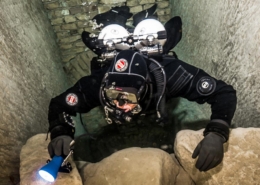How a Solid Foundation Improves Communication & Team Work
By: Jon Kieren
Recently I read a comment made by a fellow instructor regarding the importance of buoyancy control, trim and advanced propulsion techniques at the entry level technical diving courses. The comment made was that if the student knows the theory, can demonstrate the skills and are having fun; it doesn’t matter what they look like in the water. I’ve been thinking about this comment for a few days now. My thoughts on it have shifted from extreme frustration to understanding. Sometimes we just don’t know what we don’t know and that’s not necessarily our fault; we simply may not have the experience to know better… yet.
Divers and instructors that have not been exposed to the benefits of working on a solid foundation may not have the experience to see how it improves diver performance, team communication and ultimately fun. Sure, we all know that excellent trim and buoyancy control looks pretty in the water, helps avoid disturbing/damaging the environment and makes for great social media posts. However, this solid foundation is critical for a far more important reason: positioning and communication.
One of the arguments against focusing on trim and buoyancy in entry level tech courses is that there is no evidence to show that these areas are causing accidents and fatalities. Personally, I disagree. We read accident reports all the time, at all levels of diving, that “one minute he was there, the next he wasn’t.” This typically occurs during the most critical portions of the dive: the descent and ascent and is often a direct result of poor team positioning and communication.
A solid foundation of proper trim, buoyancy and finning techniques is critical to maintaining position in the water and contact with teammates.
Without this foundation, it is nearly impossible for a team to easily remain in a position where they can clearly communicate as well as assist another teammate if needed. It is common to see poorly trained divers ascend and descend swimming in one direction or another with their backs to their teammates or even swimming in circles on decompression stops. Maintaining proper position in the water column allows the team to stay together communicate throughout the ascent and descent, including decompression stops and gas switches. If a diver in the team has a problem at any point, a teammate will notice and can respond and assist quickly.
So when and where should a diver learn these important skills?
The TDI Intro to Tech program was developed to better prepare student divers for further technical diver training such as Advanced Nitrox/Decompression Procedures and Cavern/Cave training. A high-quality Intro to Tech course will focus on these basic foundational skills while introducing the student to technical diving equipment. As the diver progresses on to more advanced training, they will be able to build on a solid foundation to complete more complex tasks while maintaining position in the water column and effectively communicate with their team. Required skill performance for the TDI Intro to Tech Course include:
- Demonstrate adequate buoyancy control (ability to hover at fixed position in water column without moving hands or feet)
- Demonstrate adequate trim (ability to maintain horizontal during the descent, bottom and ascent portion of the dive)
- Demonstrate no-silting propulsion techniques: frog kick, modified frog kick, modified flutter kick, backwards kick
- Demonstrate the ability to perform the following exercises while maintaining trim and buoyancy in the water column:
- Regulator exchange
- Regulator recovery
- Mask partial flood and clear with minimal air loss
- Mask removal and clear with minimal air loss
- Demonstrate the ability to perform a safety drill (S-drill) while maintaining trim and buoyancy in the water column
- Demonstrate the ability to perform a valve drill while maintaining trim and buoyancy in the water column (if double cylinders are being used)
- Demonstrate the ability to deploy a surface marker buoy or lift bag while maintaining trim and buoyancy in the water column
- Show good situational awareness
This solid foundation will be the base which the rest of the diver’s continued training will build on. The ability to hold proper position in the water column will prove to be invaluable as the diver progresses to more complex skills as well as maintaining contact with teammates. A nice little bonus is that it does look really nice in photographs.
For more information about the TDI Intro to Tech program or to find an instructor, visit the TDI Intro to Tech course description page HERE.










השאירו תגובה
רוצה להצטרף לדיון?תרגישו חופשי לתרום!